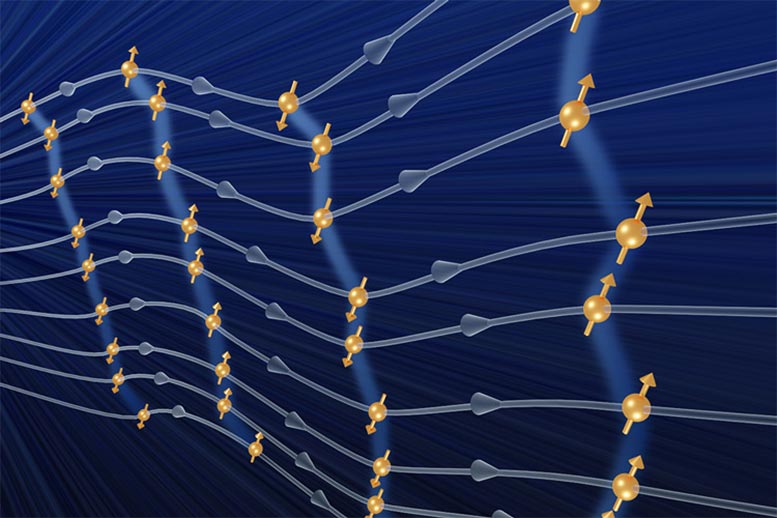UC Berkeley physicist Norman Yao first described five years ago how to make a time crystal — a new form of matter whose patterns repeat in time instead of space. Unlike crystals of emerald or ruby, however, those time crystals existed for only a fraction of a second.
But the time has arrived for time crystals. Since Yao’s original proposal, new insights have led to the discovery that time crystals come in many different forms, each stabilized by its own distinct mechanism.
Using new quantum computing architectures, several labs have come close to creating a many-body localized version of a time crystal, which uses disorder to keep periodically-driven quantum qubits in a continual state of subharmonic jiggling — the qubits oscillate, but only every other period of the drive.
In a paper published in the journal Science last week, Yao and colleagues at QuTech — a collaboration between Delft University of Technology and TNO, an independent research group in the Netherlands — reported the creation of a many-body localized discrete time crystal that lasted for about eight seconds, corresponding to 800 oscillation periods. They used a quantum computer based upon a diamond, where the qubits — quantum bits, the analog of binary bits in digital computers — are the nuclear spins of carbon-13 atoms embedded inside the diamond.
“While a perfectly isolated time crystal can, in principle, live forever, any real experimental implementation will decay due to interactions with the environment,” said QuTech’s Joe Randall. “Further extending the lifetime is the next frontier.”
The results, first posted this summer on arXiv, were replicated in a near-simultaneous experiment by researchers from Google, Stanford and Princeton, using Google’s superconducting quantum computer, Sycamore. That demonstration employed 20 qubits made of superconducting aluminum strips and lasted for about eight-tenths of a second. Both Google’s and QuTech’s time crystals are referred to as Floquet phases of matter, which are a type of non-equilibrium material.
“It is extremely exciting that multiple experimental breakthroughs are happening simultaneously,” says Tim Taminiau, lead investigator at QuTech. “All these different platforms complement each other. The Google experiment uses two times more qubits; our time crystal lives about 10 times longer.”
Qutech’s team manipulated the nine carbon-13 qubits in just the right way to satisfy the criteria to form a many-body localized time crystal.
“A time crystal is perhaps the simplest example of a non-equilibrium phase of matter,” said Yao, UC Berkeley associate professor of physics. “The QuTech system is perfectly poised to explore other out-of-equilibrium phenomena including, for example, Floquet topological phases.”
These results follow on the heels of another time crystal sighting, also involving Yao’s group, published in Science several months ago. There, researchers observed a so-called prethermal time crystal, where the subharmonic oscillations are stabilized via high-frequency driving. The experiments were performed in Monroe’s lab at the University of Maryland using a one-dimensional chain of trapped atomic ions, the same system that observed the first signatures of time crystalline dynamics over five years ago. Interestingly, unlike the many-body localized time crystal, which represents an innately quantum Floquet phase, prethermal time crystals can exist as either quantum or classical phases of matter.
Many open questions remain. Are there practical applications for time crystals? Can dissipation help to extend a time crystal’s lifetimes? And, more generally, how and when do driven quantum systems equilibrate? The reported results demonstrate that spin defects in solids are a flexible platform for experimentally studying these important open questions in statistical physics.
“The ability to isolate the spins from their environment while still being able to control their interactions offers an amazing opportunity to study how information is preserved or lost,” said UC Berkeley graduate student Francisco Machado. “It will be fascinating to see what comes next.”
References:
“Many-body-localized discrete time crystal with a programmable spin-based quantum simulator” by J. Randall, C. E. Bradley, F. V. van der Gronden, A. Galicia, M. H. Abobeih, M. Markham, D. J. Twitchen, F. Machado, N. Y. Yao and T. H. Taminiau, 4 November 2021, Science.
DOI: 10.1126/science.abk0603
“Time-Crystalline Eigenstate Order on a Quantum Processor” by Xiao Mi, Matteo Ippoliti, Chris Quintana, Ami Greene, Zijun Chen, Jonathan Gross, Frank Arute, Kunal Arya, Juan Atalaya, Ryan Babbush, Joseph C. Bardin, Joao Basso, Andreas Bengtsson, Alexander Bilmes, Alexandre Bourassa, Leon Brill, Michael Broughton, Bob B. Buckley, David A. Buell, Brian Burkett, Nicholas Bushnell, Benjamin Chiaro, Roberto Collins, William Courtney, Dripto Debroy, Sean Demura, Alan R. Derk, Andrew Dunsworth, Daniel Eppens, Catherine Erickson, Edward Farhi, Austin G. Fowler, Brooks Foxen, Craig Gidney, Marissa Giustina, Matthew P. Harrigan, Sean D. Harrington, Jeremy Hilton, Alan Ho, Sabrina Hong, Trent Huang, Ashley Huff, William J. Huggins, L. B. Ioffe, Sergei V. Isakov, Justin Iveland, Evan Jeffrey, Zhang Jiang, Cody Jones, Dvir Kafri, Tanuj Khattar, Seon Kim, Alexei Kitaev, Paul V. Klimov, Alexander N. Korotkov, Fedor Kostritsa, David Landhuis, Pavel Laptev, Joonho Lee, Kenny Lee, Aditya Locharla, Erik Lucero, Orion Martin, Jarrod R. McClean, Trevor McCourt, Matt McEwen, Kevin C. Miao, Masoud Mohseni, Shirin Montazeri, Wojciech Mruczkiewicz, Ofer Naaman, Matthew Neeley, Charles Neill, Michael Newman, Murphy Yuezhen Niu, Thomas E. O\’ Brien, Alex Opremcak, Eric Ostby, Balint Pato, Andre Petukhov, Nicholas C. Rubin, Daniel Sank, Kevin J. Satzinger, Vladimir Shvarts, Yuan Su, Doug Strain, Marco Szalay, Matthew D. Trevithick, Benjamin Villalonga, Theodore White, Z. Jamie Yao, Ping Yeh, Juhwan Yoo, Adam Zalcman, Hartmut Neven, Sergio Boixo, Vadim Smelyanskiy, Anthony Megrant, Julian Kelly, Yu Chen , S. L. Sondhi, Roderich Moessner, Kostyantyn Kechedzhi, Vedika Khemani and Pedram Roushan, 30 November 2021, Nature.
DOI: 10.1038/s41586-021-04257-w
“Observation of a prethermal discrete time crystal” by A. Kyprianidis, F. Machado, W. Morong, P. Becker, K. S. Collins, D. V. Else, L. Feng, P. W. Hess, C. Nayak, G. Pagano, N. Y. Yao and C. Monroe, 11 June 2021, Science.
DOI: 10.1126/science.abg8102
Never miss a breakthrough: Join the SciTechDaily newsletter.

3 Comments
It’s informative
This discoveries are very magnificent
These are the precursors that rip the quantum world wide open and expand the possibilities once only thought of as theory.